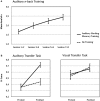The impact of auditory working memory training on the fronto-parietal working memory network
- PMID: 22701418
- PMCID: PMC3373207
- DOI: 10.3389/fnhum.2012.00173
The impact of auditory working memory training on the fronto-parietal working memory network
Abstract
Working memory training has been widely used to investigate working memory processes. We have shown previously that visual working memory benefits only from intra-modal visual but not from across-modal auditory working memory training. In the present functional magnetic resonance imaging study we examined whether auditory working memory processes can also be trained specifically and which training-induced activation changes accompany theses effects. It was investigated whether working memory training with strongly distinct auditory materials transfers exclusively to an auditory (intra-modal) working memory task or whether it generalizes to a (across-modal) visual working memory task. We used adaptive n-back training with tonal sequences and a passive control condition. The memory training led to a reliable training gain. Transfer effects were found for the (intra-modal) auditory but not for the (across-modal) visual transfer task. Training-induced activation decreases in the auditory transfer task were found in two regions in the right inferior frontal gyrus. These effects confirm our previous findings in the visual modality and extents intra-modal effects in the prefrontal cortex to the auditory modality. As the right inferior frontal gyrus is frequently found in maintaining modality-specific auditory information, these results might reflect increased neural efficiency in auditory working memory processes. Furthermore, task-unspecific (amodal) activation decreases in the visual and auditory transfer task were found in the right inferior parietal lobule and the superior portion of the right middle frontal gyrus reflecting less demand on general attentional control processes. These data are in good agreement with amodal activation decreases within the same brain regions on a visual transfer task reported previously.
Keywords: auditory; fMRI; n-back task; plasticity; training; visual; working memory.
Figures






Similar articles
-
Separating intra-modal and across-modal training effects in visual working memory: an fMRI investigation.Cereb Cortex. 2011 Nov;21(11):2555-64. doi: 10.1093/cercor/bhr037. Epub 2011 Apr 6. Cereb Cortex. 2011. PMID: 21471559
-
Cross-modal activation of auditory regions during visuo-spatial working memory in early deafness.Brain. 2015 Sep;138(Pt 9):2750-65. doi: 10.1093/brain/awv165. Epub 2015 Jun 11. Brain. 2015. PMID: 26070981
-
Management of attentional resources in within-modal and cross-modal divided attention tasks: an fMRI study.Hum Brain Mapp. 2007 Dec;28(12):1267-75. doi: 10.1002/hbm.20350. Hum Brain Mapp. 2007. PMID: 17315224 Free PMC article.
-
What Is Targeted When We Train Working Memory? Evidence From a Meta-Analysis of the Neural Correlates of Working Memory Training Using Activation Likelihood Estimation.Front Psychol. 2022 Mar 30;13:868001. doi: 10.3389/fpsyg.2022.868001. eCollection 2022. Front Psychol. 2022. PMID: 35432071 Free PMC article.
-
Review of the Neural Processes of Working Memory Training: Controlling the Impulse to Throw the Baby Out With the Bathwater.Front Psychiatry. 2020 Sep 10;11:512761. doi: 10.3389/fpsyt.2020.512761. eCollection 2020. Front Psychiatry. 2020. PMID: 33132926 Free PMC article.
Cited by
-
The neuroscience of working memory capacity and training.Nat Rev Neurosci. 2016 Jul;17(7):438-49. doi: 10.1038/nrn.2016.43. Epub 2016 May 26. Nat Rev Neurosci. 2016. PMID: 27225070 Review.
-
Intensive Working Memory Training Produces Functional Changes in Large-scale Frontoparietal Networks.J Cogn Neurosci. 2016 Apr;28(4):575-88. doi: 10.1162/jocn_a_00916. Epub 2016 Jan 7. J Cogn Neurosci. 2016. PMID: 26741799 Free PMC article.
-
Absolute beta power in exercisers and nonexercisers in preparation for the oddball task.Arq Neuropsiquiatr. 2024 Oct;82(10):1-8. doi: 10.1055/s-0044-1791518. Epub 2024 Oct 2. Arq Neuropsiquiatr. 2024. PMID: 39357852 Free PMC article.
-
Brain enhancement through cognitive training: a new insight from brain connectome.Front Syst Neurosci. 2015 Apr 1;9:44. doi: 10.3389/fnsys.2015.00044. eCollection 2015. Front Syst Neurosci. 2015. PMID: 25883555 Free PMC article. Review.
-
Training on Abacus-Based Mental Calculation Enhances Visuospatial Working Memory in Children.J Neurosci. 2019 Aug 14;39(33):6439-6448. doi: 10.1523/JNEUROSCI.3195-18.2019. Epub 2019 Jun 17. J Neurosci. 2019. PMID: 31209171 Free PMC article. Clinical Trial.
References
-
- Baddeley A. D. (1986). Working Memory. Oxford: Oxford University Press
-
- Baddeley A. D. (2002). Is working memory still working? Eur. Psychol. 7, 85–97
-
- Baddeley A. D., Gathercole S., Papagno C. (1998). The phonological loop as a language learning device. Psychol. Rev. 105, 158–173 - PubMed
-
- Baddeley A. D., Hitch G. (1974). “The psychology of learning and motivation,” in Working Memory, ed Bower G. H. (San Diego, CA: Academic Press; ), 47–89
LinkOut - more resources
Full Text Sources
Research Materials

